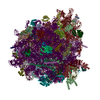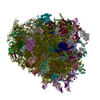+ データを開く
データを開く
- 基本情報
基本情報
| 登録情報 | データベース: PDB / ID: 7zjx | ||||||||||||||||||||||||||||||||||||||||||||||||||||||||||||||||||
|---|---|---|---|---|---|---|---|---|---|---|---|---|---|---|---|---|---|---|---|---|---|---|---|---|---|---|---|---|---|---|---|---|---|---|---|---|---|---|---|---|---|---|---|---|---|---|---|---|---|---|---|---|---|---|---|---|---|---|---|---|---|---|---|---|---|---|---|
| タイトル | Rabbit 80S ribosome programmed with SECIS and SBP2 | ||||||||||||||||||||||||||||||||||||||||||||||||||||||||||||||||||
 要素 要素 |
| ||||||||||||||||||||||||||||||||||||||||||||||||||||||||||||||||||
 キーワード キーワード | RIBOSOME / Selenocysteine / recoding / 80S | ||||||||||||||||||||||||||||||||||||||||||||||||||||||||||||||||||
| 機能・相同性 |  機能・相同性情報 機能・相同性情報forebrain neuron development / Translation initiation complex formation / Formation of the ternary complex, and subsequently, the 43S complex / Ribosomal scanning and start codon recognition / negative regulation of nuclear-transcribed mRNA catabolic process, nonsense-mediated decay / selenocysteine insertion sequence binding / selenocysteine incorporation / Major pathway of rRNA processing in the nucleolus and cytosol / GTP hydrolysis and joining of the 60S ribosomal subunit / L13a-mediated translational silencing of Ceruloplasmin expression ...forebrain neuron development / Translation initiation complex formation / Formation of the ternary complex, and subsequently, the 43S complex / Ribosomal scanning and start codon recognition / negative regulation of nuclear-transcribed mRNA catabolic process, nonsense-mediated decay / selenocysteine insertion sequence binding / selenocysteine incorporation / Major pathway of rRNA processing in the nucleolus and cytosol / GTP hydrolysis and joining of the 60S ribosomal subunit / L13a-mediated translational silencing of Ceruloplasmin expression / SRP-dependent cotranslational protein targeting to membrane / Formation of a pool of free 40S subunits / Nonsense Mediated Decay (NMD) independent of the Exon Junction Complex (EJC) / Nonsense Mediated Decay (NMD) enhanced by the Exon Junction Complex (EJC) / striatum development / ribosomal subunit / mRNA stabilization / RNA catabolic process / negative regulation of RNA splicing / negative regulation of bicellular tight junction assembly / rRNA modification in the nucleus and cytosol / Formation of the ternary complex, and subsequently, the 43S complex / laminin receptor activity / Ribosomal scanning and start codon recognition / Translation initiation complex formation / organelle membrane / TOR signaling / Protein hydroxylation / SARS-CoV-1 modulates host translation machinery / cellular response to ethanol / mTORC1-mediated signalling / Peptide chain elongation / Selenocysteine synthesis / Formation of a pool of free 40S subunits / Eukaryotic Translation Termination / ubiquitin ligase inhibitor activity / SRP-dependent cotranslational protein targeting to membrane / Response of EIF2AK4 (GCN2) to amino acid deficiency / positive regulation of signal transduction by p53 class mediator / Viral mRNA Translation / Nonsense Mediated Decay (NMD) independent of the Exon Junction Complex (EJC) / 90S preribosome / GTP hydrolysis and joining of the 60S ribosomal subunit / L13a-mediated translational silencing of Ceruloplasmin expression / ribonucleoprotein complex binding / Major pathway of rRNA processing in the nucleolus and cytosol / protein-RNA complex assembly / Nonsense Mediated Decay (NMD) enhanced by the Exon Junction Complex (EJC) / maturation of LSU-rRNA / Nuclear events stimulated by ALK signaling in cancer / laminin binding / rough endoplasmic reticulum / translation regulator activity / ribosomal small subunit export from nucleus / gastrulation / MDM2/MDM4 family protein binding / cytosolic ribosome / class I DNA-(apurinic or apyrimidinic site) endonuclease activity / DNA-(apurinic or apyrimidinic site) lyase / ribosomal large subunit biogenesis / maturation of LSU-rRNA from tricistronic rRNA transcript (SSU-rRNA, 5.8S rRNA, LSU-rRNA) / positive regulation of apoptotic signaling pathway / maturation of SSU-rRNA from tricistronic rRNA transcript (SSU-rRNA, 5.8S rRNA, LSU-rRNA) / mRNA 3'-UTR binding / maturation of SSU-rRNA / small-subunit processome / response to insulin / GABA-ergic synapse / mRNA 5'-UTR binding / Regulation of expression of SLITs and ROBOs / spindle / cytoplasmic ribonucleoprotein granule / rRNA processing / antimicrobial humoral immune response mediated by antimicrobial peptide / positive regulation of canonical Wnt signaling pathway / glucose homeostasis / heparin binding / regulation of translation / presynapse / large ribosomal subunit / ribosome binding / virus receptor activity / cell body / ribosomal small subunit biogenesis / ribosomal small subunit assembly / 5S rRNA binding / ribosomal large subunit assembly / small ribosomal subunit / small ribosomal subunit rRNA binding / large ribosomal subunit rRNA binding / cytosolic small ribosomal subunit / defense response to Gram-negative bacterium / perikaryon / SARS-CoV-2 modulates host translation machinery / killing of cells of another organism / cytosolic large ribosomal subunit / cytoplasmic translation / cell differentiation / tRNA binding / negative regulation of translation 類似検索 - 分子機能 | ||||||||||||||||||||||||||||||||||||||||||||||||||||||||||||||||||
| 生物種 |  Homo sapiens (ヒト) Homo sapiens (ヒト)  Cricket paralysis virus (ウイルス) Cricket paralysis virus (ウイルス) | ||||||||||||||||||||||||||||||||||||||||||||||||||||||||||||||||||
| 手法 | 電子顕微鏡法 / 単粒子再構成法 / クライオ電子顕微鏡法 / 解像度: 3.1 Å | ||||||||||||||||||||||||||||||||||||||||||||||||||||||||||||||||||
 データ登録者 データ登録者 | Hilal, T. / Simonovic, M. / Spahn, C.M.T. | ||||||||||||||||||||||||||||||||||||||||||||||||||||||||||||||||||
| 資金援助 |  ドイツ, ドイツ,  米国, 2件 米国, 2件
| ||||||||||||||||||||||||||||||||||||||||||||||||||||||||||||||||||
 引用 引用 |  ジャーナル: Science / 年: 2022 ジャーナル: Science / 年: 2022タイトル: Structure of the mammalian ribosome as it decodes the selenocysteine UGA codon. 著者: Tarek Hilal / Benjamin Y Killam / Milica Grozdanović / Malgorzata Dobosz-Bartoszek / Justus Loerke / Jörg Bürger / Thorsten Mielke / Paul R Copeland / Miljan Simonović / Christian M T Spahn /   要旨: The elongation of eukaryotic selenoproteins relies on a poorly understood process of interpreting in-frame UGA stop codons as selenocysteine (Sec). We used cryo-electron microscopy to visualize Sec ...The elongation of eukaryotic selenoproteins relies on a poorly understood process of interpreting in-frame UGA stop codons as selenocysteine (Sec). We used cryo-electron microscopy to visualize Sec UGA recoding in mammals. A complex between the noncoding Sec-insertion sequence (SECIS), SECIS-binding protein 2 (SBP2), and 40 ribosomal subunit enables Sec-specific elongation factor eEFSec to deliver Sec. eEFSec and SBP2 do not interact directly but rather deploy their carboxyl-terminal domains to engage with the opposite ends of the SECIS. By using its Lys-rich and carboxyl-terminal segments, the ribosomal protein eS31 simultaneously interacts with Sec-specific transfer RNA (tRNA) and SBP2, which further stabilizes the assembly. eEFSec is indiscriminate toward l-serine and facilitates its misincorporation at Sec UGA codons. Our results support a fundamentally distinct mechanism of Sec UGA recoding in eukaryotes from that in bacteria. | ||||||||||||||||||||||||||||||||||||||||||||||||||||||||||||||||||
| 履歴 |
|
- 構造の表示
構造の表示
| 構造ビューア | 分子:  Molmil Molmil Jmol/JSmol Jmol/JSmol |
|---|
- ダウンロードとリンク
ダウンロードとリンク
- ダウンロード
ダウンロード
| PDBx/mmCIF形式 |  7zjx.cif.gz 7zjx.cif.gz | 4.9 MB | 表示 |  PDBx/mmCIF形式 PDBx/mmCIF形式 |
|---|---|---|---|---|
| PDB形式 |  pdb7zjx.ent.gz pdb7zjx.ent.gz | 表示 |  PDB形式 PDB形式 | |
| PDBx/mmJSON形式 |  7zjx.json.gz 7zjx.json.gz | ツリー表示 |  PDBx/mmJSON形式 PDBx/mmJSON形式 | |
| その他 |  その他のダウンロード その他のダウンロード |
-検証レポート
| 文書・要旨 |  7zjx_validation.pdf.gz 7zjx_validation.pdf.gz | 2.5 MB | 表示 |  wwPDB検証レポート wwPDB検証レポート |
|---|---|---|---|---|
| 文書・詳細版 |  7zjx_full_validation.pdf.gz 7zjx_full_validation.pdf.gz | 2.9 MB | 表示 | |
| XML形式データ |  7zjx_validation.xml.gz 7zjx_validation.xml.gz | 423.8 KB | 表示 | |
| CIF形式データ |  7zjx_validation.cif.gz 7zjx_validation.cif.gz | 683 KB | 表示 | |
| アーカイブディレクトリ |  https://data.pdbj.org/pub/pdb/validation_reports/zj/7zjx https://data.pdbj.org/pub/pdb/validation_reports/zj/7zjx ftp://data.pdbj.org/pub/pdb/validation_reports/zj/7zjx ftp://data.pdbj.org/pub/pdb/validation_reports/zj/7zjx | HTTPS FTP |
-関連構造データ
| 関連構造データ |  14752MC  7zjwC M: このデータのモデリングに利用したマップデータ C: 同じ文献を引用 ( |
|---|---|
| 類似構造データ | 類似検索 - 機能・相同性  F&H 検索 F&H 検索 |
- リンク
リンク
- 集合体
集合体
| 登録構造単位 | 
|
|---|---|
| 1 |
|
- 要素
要素
-タンパク質 , 7種, 7分子 BLGLaLxSDSGSV
| #1: タンパク質 | 分子量: 95640.016 Da / 分子数: 1 / 由来タイプ: 組換発現 / 由来: (組換発現)  Homo sapiens (ヒト) / 遺伝子: SECISBP2, SBP2 / 発現宿主: Homo sapiens (ヒト) / 遺伝子: SECISBP2, SBP2 / 発現宿主:  |
|---|---|
| #9: タンパク質 | 分子量: 34523.863 Da / 分子数: 1 / 由来タイプ: 天然 / 由来: (天然)  |
| #28: タンパク質 | 分子量: 17768.246 Da / 分子数: 1 / 由来タイプ: 天然 / 由来: (天然)  |
| #47: タンパク質 | 分子量: 24875.410 Da / 分子数: 1 / 由来タイプ: 天然 / 由来: (天然)  |
| #52: タンパク質 | 分子量: 18004.041 Da / 分子数: 1 / 由来タイプ: 天然 / 由来: (天然)  |
| #55: タンパク質 | 分子量: 35115.652 Da / 分子数: 1 / 由来タイプ: 天然 / 由来: (天然)  |
| #67: タンパク質 | 分子量: 18933.846 Da / 分子数: 1 / 由来タイプ: 天然 / 由来: (天然)  |
-RNA鎖 , 6種, 6分子 IL5L7L8SS2
| #2: RNA鎖 | 分子量: 52131.645 Da / 分子数: 1 / 由来タイプ: 合成 / 由来: (合成)  Cricket paralysis virus (ウイルス) Cricket paralysis virus (ウイルス) |
|---|---|
| #3: RNA鎖 | 分子量: 1557505.375 Da / 分子数: 1 / 由来タイプ: 天然 / 由来: (天然)  |
| #4: RNA鎖 | 分子量: 38851.871 Da / 分子数: 1 / 由来タイプ: 天然 / 由来: (天然)  |
| #5: RNA鎖 | 分子量: 50809.047 Da / 分子数: 1 / 由来タイプ: 天然 / 由来: (天然)  |
| #48: RNA鎖 | 分子量: 275721.688 Da / 分子数: 1 / 由来タイプ: 合成 / 由来: (合成)  |
| #49: RNA鎖 | 分子量: 603814.125 Da / 分子数: 1 / 由来タイプ: 天然 / 由来: (天然)  |
+60S ribosomal Protein ... , 34種, 34分子 LDLELFLHLILJLKLMLOLPLRLSLTLULVLWLXLYLcLdLeLfLgLiLjLkLlLnLoLp...
-Ribosomal protein ... , 7種, 7分子 LLLQLZLbLhLmSQ
| #14: タンパク質 | 分子量: 24643.057 Da / 分子数: 1 / 由来タイプ: 天然 / 由来: (天然)  |
|---|---|
| #18: タンパク質 | 分子量: 24207.285 Da / 分子数: 1 / 由来タイプ: 天然 / 由来: (天然)  |
| #27: タンパク質 | 分子量: 17825.111 Da / 分子数: 1 / 由来タイプ: 天然 / 由来: (天然)  |
| #29: タンパク質 | 分子量: 17303.363 Da / 分子数: 1 / 由来タイプ: 天然 / 由来: (天然)  |
| #35: タンパク質 | 分子量: 15898.932 Da / 分子数: 1 / 由来タイプ: 天然 / 由来: (天然)  |
| #40: タンパク質 | 分子量: 11111.032 Da / 分子数: 1 / 由来タイプ: 天然 / 由来: (天然)  |
| #62: タンパク質 | 分子量: 22913.453 Da / 分子数: 1 / 由来タイプ: 天然 / 由来: (天然)  |
+40S ribosomal protein ... , 29種, 29分子 SBSCSESFSHSLSMSNSOSPSRSSSTSUSWSXSYSZSaSbScSdSeSfSgShSiSjSk
-非ポリマー , 1種, 8分子 
| #84: 化合物 | ChemComp-ZN / |
|---|
-詳細
| 研究の焦点であるリガンドがあるか | Y |
|---|---|
| Has protein modification | Y |
-実験情報
-実験
| 実験 | 手法: 電子顕微鏡法 |
|---|---|
| EM実験 | 試料の集合状態: PARTICLE / 3次元再構成法: 単粒子再構成法 |
- 試料調製
試料調製
| 構成要素 |
| ||||||||||||||||||||||||||||||||||||
|---|---|---|---|---|---|---|---|---|---|---|---|---|---|---|---|---|---|---|---|---|---|---|---|---|---|---|---|---|---|---|---|---|---|---|---|---|---|
| 分子量 | 値: 3.5 MDa / 実験値: NO | ||||||||||||||||||||||||||||||||||||
| 由来(天然) |
| ||||||||||||||||||||||||||||||||||||
| 由来(組換発現) |
| ||||||||||||||||||||||||||||||||||||
| 緩衝液 | pH: 7.6 | ||||||||||||||||||||||||||||||||||||
| 試料 | 包埋: NO / シャドウイング: NO / 染色: NO / 凍結: YES | ||||||||||||||||||||||||||||||||||||
| 急速凍結 | 装置: FEI VITROBOT MARK II / 凍結剤: ETHANE / 湿度: 100 % |
- 電子顕微鏡撮影
電子顕微鏡撮影
| 実験機器 |  モデル: Tecnai Polara / 画像提供: FEI Company |
|---|---|
| 顕微鏡 | モデル: FEI POLARA 300 |
| 電子銃 | 電子線源:  FIELD EMISSION GUN / 加速電圧: 300 kV / 照射モード: FLOOD BEAM FIELD EMISSION GUN / 加速電圧: 300 kV / 照射モード: FLOOD BEAM |
| 電子レンズ | モード: BRIGHT FIELD / 最大 デフォーカス(公称値): 2000 nm / 最小 デフォーカス(公称値): 800 nm / アライメント法: COMA FREE |
| 試料ホルダ | 凍結剤: NITROGEN |
| 撮影 | 電子線照射量: 25 e/Å2 / 検出モード: SUPER-RESOLUTION フィルム・検出器のモデル: GATAN K2 SUMMIT (4k x 4k) 撮影したグリッド数: 1 / 実像数: 6908 |
- 解析
解析
| EMソフトウェア |
| ||||||||||||||||||||||||||||||||||||
|---|---|---|---|---|---|---|---|---|---|---|---|---|---|---|---|---|---|---|---|---|---|---|---|---|---|---|---|---|---|---|---|---|---|---|---|---|---|
| CTF補正 | タイプ: PHASE FLIPPING AND AMPLITUDE CORRECTION | ||||||||||||||||||||||||||||||||||||
| 粒子像の選択 | 選択した粒子像数: 179421 | ||||||||||||||||||||||||||||||||||||
| 対称性 | 点対称性: C1 (非対称) | ||||||||||||||||||||||||||||||||||||
| 3次元再構成 | 解像度: 3.1 Å / 解像度の算出法: FSC 0.143 CUT-OFF / 粒子像の数: 39295 / 対称性のタイプ: POINT | ||||||||||||||||||||||||||||||||||||
| 原子モデル構築 | プロトコル: RIGID BODY FIT / 空間: REAL | ||||||||||||||||||||||||||||||||||||
| 原子モデル構築 | PDB-ID: 7O7Y Accession code: 7O7Y / Source name: PDB / タイプ: experimental model |
 ムービー
ムービー コントローラー
コントローラー




 PDBj
PDBj






































